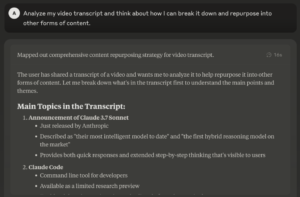
Anthropic has released Claude 3.7 Sonnet, a highly-anticipated upgrade to its large language model (LLM) family. Billed as the company’s “most intelligent model to date” and the first hybrid reasoning AI on the market, Claude 3.7 Sonnet introduces some major enhancements over its predecessor (Claude 3.5 Sonnet) in speed, reasoning, and real-world task performance.
The rollout comes amid fast advances from competitors like OpenAI and xAI’s recent Grok 3, leading many AI enthusiasts (including me) to view this launch as Anthropic’s answer to recent innovations. The new model aims to blend quick conversational answers with deeper analytical thinking in one system – a unified approach that could show us what future interaction with AI will look like.
Long-Awaited Upgrade to a Beloved AI Assistant
For many regular AI users, Claude 3.5 Sonnet had already been a go-to tool. It was regarded as one of the best out there. However, in recent months Anthropic faced growing pressure. The AI industry has been going crazy with new features and models – OpenAI’s ChatGPT gained voice, multi-step reasoning abilities, and deep research. Grok 3 made its debut with real-time X data, and other platforms like Perplexity and Gemini kept the releases coming. Many observers started to note that Anthropic was starting to fall behind. The community had been eagerly awaiting Anthropic’s response, with expectations that a new Claude model was due any day.
Claude 3.7 Sonnet arrived at last to meet those expectations. It is a significant leap forward from Claude 3.5, rather than a minor tweak. Anthropic touts it as a comprehensive upgrade: faster, smarter, and more versatile.
The model’s speed and output quality are striking. In my own tests, I found it to be incredibly fast compared to the last version, processing lengthy text inputs almost instantaneously. Given Anthropic’s slow update cycle, the 3.7 release feels like a long-awaited catch-up that reclaims Claude’s position in the AI race. Claude 3.7 doubles down on what made users love Claude 3.5 – exceptional performance in practical tasks – while adding innovative reasoning capabilities under the hood.
Hybrid Reasoning: Quick Answers and Deep Thinking in One
The headline feature of Claude 3.7 Sonnet is its hybrid reasoning capability. In simple terms, this model can operate in two modes: a standard mode for near-instant responses, and a new “extended thinking” mode where it works through problems step-by-step, showing its chain-of-thought to the user.
Rather than releasing a separate Claude reasoning edition, Anthropic has merged both quick and deep thinking into one AI. “Just as humans use a single brain for both quick responses and deep reflection, we believe reasoning should be an integrated capability… rather than a separate model entirely,” the company explained in its announcement, emphasizing a unified approach for a seamless user experience.
In practice, this means users can decide when they want a fast answer and when to let Claude deliberate at length. A simple toggle lets you switch to extended mode if a question requires detailed analysis or multi-step logic. In standard mode, Claude 3.7 Sonnet functions like an improved version of 3.5 – faster and more refined, but with the familiar quick conversational style. In extended mode, the AI “self-reflects” before answering, writing out its reasoning process internally (and making it visible) to arrive at more accurate or complex solutions.
The chain-of-thought scrolls out step by step on screen, a feature that has become popular in other advanced AI systems and now finally comes to Claude.

Alex McFarland/Unite AI
Anthropic’s philosophy here deliberately contrasts with some competitors. OpenAI, for instance, has offered separate models or modes, which some find confusing to juggle. Claude 3.7’s all-in-one approach is meant to simplify things for users. Switching between modes is straightforward, and prompt style remains the same. Power users can even fine-tune how much the AI thinks: through the API, developers can set a token budget for reasoning, telling Claude how long to ponder (from just a few steps up to a massive 128k-token thought process) before finalizing an answer. This granular control lets one trade off speed for thoroughness on demand.
Key Improvements in Claude 3.7 Sonnet:
Here are some of the main improvements that we see from Claude 3.7 Sonnet:
- Hybrid Reasoning Modes – Offers both instant answers and an Extended Thinking mode where the AI works through problems stepwise with visible reasoning. Users choose the mode per query, unifying fast chat and deep analysis in one system.
- Unified Model Philosophy – Integrates quick and reflective thinking in a single AI “brain” for ease of use. This contrasts with rivals requiring multiple models or plugins, reducing complexity for the end-user.
- Speed and Responsiveness – Delivers answers faster than Claude 3.5. Early tests show noticeably snappier performance in standard mode.
- Expanded Thinking Control – Through the API, users can limit or extend the AI’s reasoning length (up to 128,000 tokens) to balance speed vs. quality as needed. This ensures extended mode is used only as much as necessary.
- Real-World Task Focus – According to the company, Claude 3.7’s training was shifted toward practical business and creative tasks rather than tricky math Olympiad puzzles. The model excels at everyday problem-solving and tasks that reflect common use cases.
- Coding and Tool Use – Stronger performance in programming tasks, especially front-end web development. Anthropic even launched a companion tool, Claude Code, which allows developers to use Claude from the command line for writing and fixing code. Early benchmarks show Claude 3.7 topping charts in solving real software issues.
Limitations and What’s Next for AI Users
Despite all the excitement, Claude 3.7 Sonnet is not without limits, and it is not a magic bullet for all AI challenges. For one, Anthropic consciously de-emphasized certain domains in training this model. They “optimized somewhat less for math and computer science competition problems” in favor of more everyday business tasks. This means that while Claude 3.7 can certainly solve math and coding questions (often better than 3.5 could), it might not top the leaderboard on every academic benchmark or puzzle. Users whose needs skew toward complex math proofs or specialized coding contests might still find areas where Claude’s answers require double-checking or where a competitor’s model tuned for that niche does better. Anthropic seems to have accepted this trade-off, aiming the model at practical utility over theoretical prowess.
Additionally, Extended Thinking mode, while powerful, introduces some complexity. It is inherently slower than the standard mode; when the AI is in deep thought, users will notice a brief pause as it works through its reasoning. This is expected – trading speed for thoroughness – but it means users must decide when they actually need that extra power. In many everyday chat queries, the standard mode will suffice and be more efficient. There is also the fact that extended reasoning can sometimes overdo it and provide a lot more than you actually need. In some cases, this could overwhelm or veer off track. Anthropic will need to ensure that the AI’s willingness to “go big” with ideas remains relevant and on-topic. Users may learn to prompt more precisely or set token limits to curb runaway tangents.
In terms of knowledge and modalities, Claude 3.7 remains primarily a text-based model. Unlike ChatGPT’s vision features or other models incorporating image or voice inputs, Claude does not yet natively “see” images or speak aloud. Its strength is in textual understanding and generation. For most, this is not necessarily a downside – but those hoping for a Claude that can analyze a photo or handle voice commands will have to wait for future iterations. Anthropic has not announced any multimodal functionality in Sonnet at this time. The focus has clearly been on refining the core language abilities and reasoning process.
The Bottom Line
Claude 3.7 Sonnet’s release is a statement that Anthropic is very much in the game alongside OpenAI, Google/DeepMind, and new players like xAI. For AI enthusiasts and developers, it adds another top-tier model to experiment with, one that offers a unique twist with its hybrid reasoning.
In the competitive AI industry, Anthropic’s latest move may also influence how companies position their models. By choosing not to do a massive model size jump or a glitzy multi-modal demo, but instead refining the user experience (unification of modes, speed, practical use cases), Anthropic is carving a niche focused on usability and reliability.
Overall, Claude 3.7 Sonnet is a pivotal moment for Anthropic. It is an evolution of the Claude series that shows the company learning from the community’s needs – doubling down on strengths while addressing weaknesses. There are still areas to watch (and future Claude iterations to anticipate), but this release has clearly re-energized Anthropic’s user base.
The post Claude 3.7 Sonnet is Anthropic’s AI Resurgence appeared first on Unite.AI.

